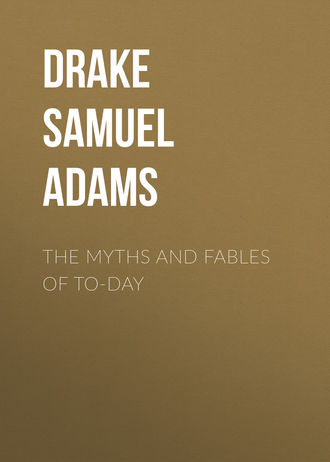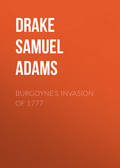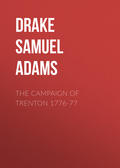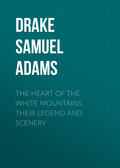
Drake Samuel Adams
The Myths and Fables of To-Day
VI
CHARMS AGAINST DISEASE
“I’ll do, I’ll do, and I’ll do.” —Shakespeare.
Under this heading we shall first call attention to those plants having the alleged power to cure disease or protect from evil influences. But before doing so, we would suggest that the reader turn to his standard or popular dictionary. He will there find the magical word “abracadabra” defined as a charm against fevers.
In former times, the young, unrolled fronds of the male fern were supposed to guard the wearer against the Evil Eye or witchcraft; and were not only worn by the credulous, but also given to the cattle as a charm against being bewitched.13 Moonwort fern had the reputation of being able to undo any lock, bolt, or bar, or even to draw nails from the shoe of any horse treading upon it; and mistletoe to be a sure cure for the stone.
The roots and flowers of violets are supposed to moderate anger, and to comfort and strengthen the heart – hence the significant name of heartsease.
St. – John’s-wort is still gathered in some parts of the Old Country on the Eve of St. John the Baptist, and hung out over the windows and doors, in accord with the ancient superstition that it would keep out all evil spirits, and shield the inmates from storms and other calamities.
The belief associated with holly, now so generally used for Christmas decoration, comes from Pliny, who writes that “the branches of this tree defend houses from lightning, and men from witchcraft.” The common mullein was also held to have potency against hurts inflicted by wild beasts, or any evil coming near; and, similarly, the mountain ash was considered a protection against the Evil Eye, witches, and warlocks. So, also, a sea-onion was often hung in the doorway, with a like object.
Another charm said to be very efficacious, though the writer has not tried it himself, yet having the sanction of age, is this: “Against a woman’s chatter, taste at night, fasting, the root of a radish; on that day the chatter cannot harm thee.”
Many of the myths concerning plants still exist in a modified form among us, although it is no doubt true that most people who decorate their houses with evergreens and holly at Christmastide are ignorant of the mysticism they so innocently perpetuate. Yet the Puritan fathers of New England were as utterly opposed to the decorating of houses of worship with “Christmas Greens,” as to the observance of the day itself. Could they but revisit the scenes of their earthly labors during that season of unstinted festivity and good cheer, when man’s heart is so warmed through the medium of his stomach, how shocked they would be to see
“Gilt holly with its thorny pricks,
And yew and box, with berries small,
These deck the unused candlesticks,
And pictures hanging by the wall.”
Beyond a doubt, most of the long-standing beliefs, touching the remedies for this or that ailment, belong to a time when the services of a skilled physician or surgeon were not to be had for love or money, or medical aid be instantly summoned to the sick man’s bedside by telephone. This was especially true of the sparsely settled parts of the country, where every prudent housewife laid in a stock of roots and herbs against sickness in the family. Some of what nowadays are called “popular remedies,” are found in Josselyn’s “Rarities.” Here are a few of them: —
“The skin of a hawk is good to wear on the stomach for the pain and coldness of it. Lameness (or rheumatic pains) may be cured by lying on a bearskin. Seal oil being cast upon coals will bring women out of their mother fits.” The white cockle-shell was very good to stanch blood. For a rattlesnake bite, “their hearts swallowed fresh, is a good antidote against their Venom, and their liver (the Gall taken out) bruised and applied to their Bitings is a present Remedy – ” a clear proof, it seems to us, that the theory of similia similibus curantur, did not originate with Dr. Koch, or even with the justly eminent Professor Pasteur.
But even the wonderful advance made by medical science is powerless to eradicate the superstitions concerning disease, which live and thrive in spite of progress, like the noxious weeds that baffle all the farmer’s vigilance. Then, there is a considerable constituency who, after making a trial of the regular school of medicine, to no avail, naturally fall back upon the flotsam and jetsam of bygone times, as a drowning man is said to grasp at a straw. As regards the former statement it may be asserted, as of personal knowledge, that inherited diseases, such as humors, scrofula, fits and the like, and even birthmarks, in many parts of the country, are still looked upon and talked about, not as a misfortune, but as a visitation upon the family so afflicted. I once heard one of these unfortunates described as “that fitty man.”
The advent of Sirius, or the dog-star, was formerly supposed to exert an occult influence upon poor humanity. In that critical season all people were advised to look carefully to their diet, to shun all broiled, salted, and strong meats, and to drink small beer and such other liquors as aids to digestion.
As touching those natural objects having reputed curative properties or virtues, perhaps the common horsechestnut is the most familiar, for the widespread belief in its power to charm away the rheumatism. Several gentlemen of my acquaintance habitually carry this magical nut on their persons, and one was actually found in the pocket of a drowned man while this chapter was being written. Yet I have known those who preferred the potato. A gentleman to whom I happened to mention the subject one day, to my profound surprise, immediately drew forth a healthy-looking tuber of a large size, which he emphatically asserted to be the only thing that had ever relieved a severe attack of rheumatism. I have also known nutmegs to be perforated, and hung round the neck, for a similar purpose.
Wearing eel-skin garters is also more or less practised as a cure for the same complaint.
Putting sulphur in the shoes is also highly commended as a cure for rheumatism. I have known the same thing done as a preventive against an attack of grippe.
Plain or galvanized iron finger rings are also worn for their supposed property to cure the rheumatism.
Another well-to-do business man gravely assured me that a nutmeg, suspended round the neck by a string, was a sure cure for boils “ – and no mistake about it – ” and strongly urged giving it a trial.
Corns and warts likewise are cured by carrying a horsechestnut on the person. Another way is to rub the wart with a copper coin, throwing the coin away immediately after. The person picking it up transfers the fungus to himself. Still another way is to first stick a pin in the wart, then to go and stick the same pin into an apple tree, though in England they say it must be an ash. The notion that such things were “catching” seems to have suggested, in a way to be easily understood, the theory of disease transference, to common folk. With this view a puppy is sometimes put into the same bed with a sick child, in the belief that the sickness will pass from the child to the puppy, while both are asleep. A case, in which this remedy was tried, came to my knowledge very recently.
To return to the subject of warts, some countryfolk highly recommend making the sign of the cross against the chimney-back with a piece of chalk, asserting that, as soon as the mark is covered with soot, the warts will go away. Others, equally skilled in this sort of cures, contend that if you steal some beans, and secretly bury them in the ground the disagreeable excrescences will leave you. Should all else fail you must then sell your warts or corns to somebody. Who’ll buy? Who’ll buy?
Should you have a decayed tooth extracted, the molar must instantly be thrown into the fire, or you will surely have a cat’s tooth come in its place. To dream of losing your teeth is, by many, considered a sure sign of coming trouble. Jet, powdered and mixed with wine, was once thought to be a sure remedy for the toothache.
Wearing a caul is a sure protection against drowning.
One must not kiss a cat; the doing so will expose one to catch some disease.
Hostlers and stable boys believe that it keeps horses healthy to have a goat about the stable.
A gold wedding-ring is believed to be a cure for sties.
Wearing red yarn around the neck is esteemed a prevention against nose-bleeding.
Sticking your jack-knife into the head of the bed will prevent cramps. Another way is to put both your slippers by your bedside, bottoms up, before retiring for the night. Should you neglect this, the cramps will surely return. The gentleman who gave me this receipt, said he got it from his mother. The old way, as laid down in the books, was to lay out your shoes in the form of a cross, before retiring.
In some country districts, a heavy growth of foliage is considered a certain forerunner of coming sickness. The blossoming of trees, in autumn, also forebodes an epidemic of sickness.
It is a matter of common knowledge, that tooth charmers continue to carry on a more or less lucrative trade in the country towns. “What did she do to you?” was asked of a countryman who had just paid a visit to one of these cunning women, at the urgent solicitation of a friend. “Do?” was the bewildered answer, “why, she didn’t do nothing at all, but just said over something to herself, and the pain was all gone in a minute.” This person, like a great many others, had a rooted aversion to having a tooth “hauled,” as he expressed it, and would have suffered untold tortures from an aching tooth, rather than have gone to a regular practitioner. One woman, in particular, whom I have in mind, enjoys a wide reputation in the neighborhood where she practises her healing art. She simply mutters some incantation, or spell, and presto! the most excruciating pain is conjured away; so ’tis said.
There is a very old belief touching the virtue of a halter, that has done service in hanging a criminal, to charm away the headache. Probably other powers are attributed to this barbarous instrument of death, for it is said to be a fact, that the negroes of the southern States will pay a great price for a piece of the hangman’s noose, to be kept in the house, as a charm.
The madstone is claimed to be a certain remedy for the bite of rabid dogs, snake bites and the like. The wonderful cures effected by one of these magic stones, owned by a lady living in Mississippi (references being given to quite a number of well-known people, who had either tested the remarkable properties of this particular stone, or who had personal knowledge of the facts), went the rounds of the newspapers some years ago. Upon being applied to the wound or bite, the stone adhered to it until the virus was absorbed. It then fell off, and after being well cleaned, was again applied until it failed to hold. When this took place, the patient was considered out of danger. With this stone it was claimed that the bite of a mad dog could be cured at any time before hydrophobia had set in.
A similar case is reported from Virginia, with details that leave no doubt of the honesty of the principals concerned.
This was the famous Upperville madstone, which has been in the hands of the Fred family for over one hundred and fifty years. As its name indicates, the peculiar property of this stone is its apparent appetite for the virus to be found in the wound made by the bite of any venomous animal. This is the owner’s story:
“The stone was brought to Virginia in 1740 by Joshua Fred, who was a well-to-do farmer in Warwickshire, England, and became an important landowner in Fauquier County. By his wish his descendants had clung to this stone as a priceless heirloom, and I am proud to say that their use of it has always reflected credit upon the good, old-fashioned hospitality and kindliness characteristic of Virginians. It was well known all over the country that anybody might go to the Fred farm with any unfortunate who had been bitten by a dog, and enjoy a certain cure without any cost. For a hundred years none of the Freds would permit any one who was cured in this way by the madstone to pay a farthing, even for board or lodging or horse feed. In later years the vicissitudes of peace and war having somewhat affected the fortunes of various members of the family, it became the practice to allow visitors who came to use the madstone to pay what they pleased for their entertainment and for the care of their teams. Beyond this, however, no charge whatever was made for scores of most remarkable cures.
“A journal was kept by the various members of the family who had charge of the madstone, in which was entered the name and age of every person on whom it was used, and the character of the wound treated. The entries in this book, made in the quaint handwriting of member after member of the family, the most of whom have long since turned to dust in their graves, are most interesting.
“While the stone was in my possession I had occasion several times to use it upon persons who were brought to me in great agony of mind over wounds they had received from the bite of rabid dogs. The last case occurred just a few days before the sale of the stone. A young boy was brought to my house late at night, who had been bitten on the wrist. The wound was an ugly one, and the father was in great distress of mind for fear hydrophobia would set in. I placed the stone on the boy’s wrist at about ten o’clock and went to bed. The father stayed up and took care of the boy. At two o’clock in the morning, he said, the stone let go. The boy was then sound asleep. The father placed the stone, as I had told him to do, in a glass of milk, on which, when I saw it in the morning, there was a thick green scum. This seemed to be the usual result in all such cases. The stone was never known to let go until it had extracted all the poison, and, on being placed in a glass of warm water or milk, discharged a greenish liquid. The stone itself is perhaps an inch long by three-quarters wide, and is of a velvety, grayish brown color. Years ago it was accidentally broken in two, and the jeweller who placed a gold band around it to hold it together has told me that the inside was a little darker than the outside and was arranged in concentric layers.”14
As an antidote against the bite of a dog, you must procure some of the hair of the dog that has bitten you. This has passed into a proverb among habitual topers, with particular reference to taking another “nip.”
There is also a more or less current belief, better grounded perhaps than many others of a like nature, that a dog which has bitten a person should not be killed until unmistakable symptoms of rabies have appeared.
Who does not remember the “blue-glass craze” of some fifteen years ago, which spread like wildfire over the land, and as suddenly died out? Whole communities went blue-glass mad. It was enough for some one to have advanced the theory that the cerulean rays were a cure-all, for everybody to accept it with as much confidence as if it had been one of the demonstrated facts of science. Dealers in blue-glass were about the only ones to benefit by the craze which infallibly suggests its own moral, namely, that credulity has not wholly disappeared. Is this doubted when hardly a day goes by in which some miraculous cure is not heralded abroad by the newspapers? Sometimes it is performed merely by the laying on of hands; and most often without the aid of medicines. Indeed, within a few years, there has sprung up a new school of healing, numbering its tens of thousands proselytes, which not only sets all the best established principles and traditions of the old schools at defiance, but also literally “throws physic to the dogs.”
The practice of dipping in the healing waters of the ocean as a cure-all, or preventive of disease for the coming year, formerly prevailed on the Maine coast, particularly at Old Orchard Beach and in the immediate neighborhood, to a very great extent. In its nature and inception the practice certainly more nearly approached the character of those annual pilgrimages made to the famous shrines of the Old World than anything which has come to my notice. Not to mince words, it proceeded from the same superstitious idea, just how originating no one can say. So, every year, on the anniversary of St. John the Baptist’s day, a curious assemblage of country-folk, for miles around, moved by a common impulse, wended their way to the nearest beaches, there to dip in the briny waters, believed to be invested with especial healing powers on this day only, like the bargains advertised to draw custom, and thereby be freed from all the ills which flesh is heir to. On that sacramental day of days, one saw a long string of nondescript wagons, loaded with old and young, moving along the sandy roads leading down from their inland homes to the salt sea. Even the school children thought that they, too, must dip, in imitation of their elders. For some unknown reason, the day, which not only had the sanction of long custom but also is hallowed by such venerated traditions, was given up for the 26th, which is quite like any other day of the year.
As all superstitious folk are generally the last to admit that they are so, so in this instance the followers of this singular custom in general either maintain a discreet silence on the subject, or refuse to say more than that they go to the beach to bathe, on a fixed day, and at no other time, because other folks do so. The custom undoubtedly arose from a firm belief in the miraculous power of the waters to heal the sick, make the weak strong and the lame to walk – on that day only. That it is a most healthful one few will deny, and as cleanliness is said to be next to godliness, an annual dip at Old Orchard is, at least, one step toward the more spiritual condition.
But it would be a mistake to suppose this singular custom to be an article of religious faith. It simply illustrates the mental and moral stamina of the period in which it flourished. For if founded in faith alone, there is strong probability that it might have survived the ridicule to which it has mostly, if not quite, succumbed.
Whether it be merely a coincidence or not, it is fact that June 26th is also the anniversary of the festival of St. Anne, to whose shrine annual pilgrimages are made by the faithful in the northern parts of the United States and in Canada for purposes quite similar to those which once attracted a host of bathers to the Maine beaches, with the difference that the Canadian shrine can show many visible tokens of its marvellous curative powers, to be seen of all men. A visitor to the little church of St. Anne, de Beaupré, remarks that “by far the most conspicuous feature of the place was a towering trophy of crutches and canes raised within the altar rail. These were of all sizes and shapes. Two fresh additions rested against the rail, where they had been left by their recovered owners.”
Apparently authentic accounts of miracles, performed at this venerated shrine, appear from time to time in the Canadian newspapers. One of these relates, as a matter of news, that “a young girl named Marie Levesque, who had only walked with difficulty during the last two years, with the aid of crutches, was radically cured. The second case was that of a young Irish lad, who, on returning from the church to the boat which was to take him to Quebec, suddenly threw away his crutch, exclaiming to one of his companions as he did so, ‘Oh! I forgot to leave my crutch in the church.’ ‘But you will want it again,’ was the reply. ‘No, not at all: I have no longer any use for it.’ And with that, he began walking about the deck, to all appearance as well as ever.”
In addition to these cases, which come to us through reputable sources, the Quebec Gazette records the following: “A man named Renaud, who accompanied the party from St. James’ parish on Saturday, and who for three years has had one side of his body completely paralyzed, was able on Sunday to walk out of church leaning on the arm of his brother. A farmer named Moulin, from Laprairie, who has been deaf for five years, fell on the floor apparently senseless, just as the officiating priest was pronouncing the benediction. He declared that when the priest raised his hands he could feel a touch upon his ear, and at the same moment, hearing the low tones of the Holy Father, fainted away from excess of joy. He is said to have been in perfect possession of his sense of hearing on his return home. Another man, who had lost his sight through an attack of typhoid fever a year and a half ago, states that immediately after crossing himself with the holy water he was well able to see all that was going on. His name is Bruneau, and he is a Lavaltrie farmer.”
The following cure for the croup was communicated to me by a very respectable farmer now deceased. After talking of various remedies for this dreaded scourge to young children, my informant observed that he knew a sure cure for it. Said he: “Take a live chicken, cut it open and take out the gizzard. Throw that into a basin of cold water and let it stay there. I know, for I’ve seen it tried; but the chicken must be alive after the operation.”
Of a like nature was the advice given to a poor country woman who was dying of consumption, by one of those female charlatans who have so legitimately replaced the fearsome witch doctors of the past. The patient was told that if she would swallow a live frog daily it would cure her. Poor creature! she had half the boys in the village catching frogs for her, and kept them in a tub in the cellar, where they could be handy. The treatment proved too heroic. She died.
It is a fact that touching for the King’s Evil has been practised in New England as late as 1815, perhaps even later. By far the most remarkable instance of the possession of this power that has been recorded upon what seems like incontrovertible evidence, is that of Lieutenant William Robbe of Peterborough, New Hampshire.15 One feature of his treatment, which no doubt served to draw many clients to him, was the practice of giving to each afflicted person a piece of silver. In fact, so many applied that the lieutenant was seriously interrupted in his legitimate occupations.
A Doctor Young, who in the account referred to is described as having been an eminent practitioner for more than forty years in the town, is said to have declared that infants afflicted with scrofulous diseases, tumors and the like, too obstinate to yield to medical aid, did unquestionably receive almost immediate relief from the healing hand of Lieutenant Robbe.
The wonderful healer continued to practise his semi-miraculous treatment until he was no longer able to raise his hands, but even then, so eager were the applicants, many of whom came from a distance, not to be disappointed, that the feeble hands were lifted for him to the sufferer’s head.
In “Supernaturalism in New England,” Mr. Whittier speaks of one Austin, a New Hampshire Quaker, who practised mental healing in his day. Those who were unable to visit him were treated by letter. In truth, there is no new thing under the sun.






